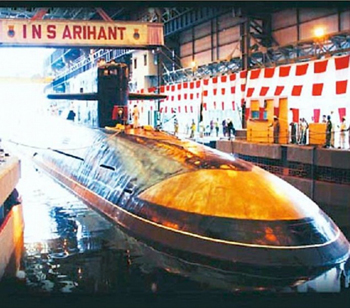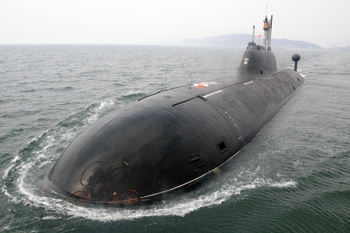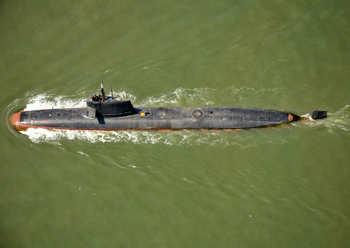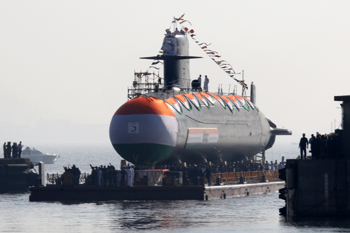INDIAN ARMED FORCES CHIEFS ON
OUR RELENTLESS AND FOCUSED PUBLISHING EFFORTS

SP Guide Publications puts forth a well compiled articulation of issues, pursuits and accomplishments of the Indian Army, over the years

I am confident that SP Guide Publications would continue to inform, inspire and influence.

My compliments to SP Guide Publications for informative and credible reportage on contemporary aerospace issues over the past six decades.
- Prime Minister witnesses 'Bharat Shakti' – a Tri-Services Firing and Manoeuvre Exercise in Pokhran, Rajasthan
- Interim Defence Budget 2024-25 — An Analysis
- Union Defence budget 2024
- Prime Minister Modi Commemorates Indian Navy Day in a Grand Ceremony
- Prime Minister Modi Flies in the LCA Tejas
- New Chapter in India-Italy Defence Ties
- Airpower beyond Boundaries
Rejuvenation – A Crying Need for India's Submarine Fleet
There is an emerging view that despite the approved programmes for rejuvenation, India is unlikely to have a credible submarine fleet by 2030 to match the emerging prowess of China in this segment of maritime power.
 |
By Rear Admiral Sushil Ramsay (Retd) Senior Editorial Advisor, SP's Naval Forces |




The Story thus far
The Golden Jubilee year of the Indian Navy's Submarine Arm, is the most opportune time to introspect its growth curve over the past fifty years. The induction of first of Soviet origin, Foxtrot Class, Diesel Electric Submarine, INS Kalvari heralded the birth of Submarine Arm for Indian Navy in December 1967. Initial years were euphoric as the planned induction progressed steadily under the time-tested Friendship treaty with USSR. Induction of newer and advanced version of conventional submarines, 877EKM under the same arrangements saw defining edge added to the Force.
Clearly the focused priority was to go for the best of the offered platforms for the Fleet. This was evidenced when new vistas were opened by not just inducting state of the art German HDW Submarines, but also for its indigenous construction. With much fanfare, the submarine production line was established at Mazagon Docks Ltd. (MDL) very successfully. After initial jubilations over a path-breaking achievement in India's indigenous warship building capabilities, the controversies struck wide and deep, resulting in total and irreplaceable loss in this vital segment of indigenous submarine building infrastructure, facilities, capabilities, skill-sets, etc.
The collapse of the Soviet Union dealt a severe blow to the product support, sustaining maintenance facilities and the avenues for modernization of the aging submarines. Having probed all other possible sources, the Indian Navy fell back on its time-tested ethos of Self-Reliance through Indigenisation. The result was a comprehensive 30-years long term perspective plan for submarine building and modernization of the aging Submarine Fleet. The Approval-in-Principle of the Government was promptly endorsed in the year 2004. The hope of rejuvenation of the Fleet was rekindled for a viable and technologically future ready force levels to be in place by the year 2025.
The timing for the launch of perspective plan was most significant when China was still grappling with its own modernization plans for the Peoples' Liberation Army (Navy). Had the successive Governments realized the strategic importance of the Perspective Plan for the rejuvenation of Submarine Arm and supported it to the hilt, the emerging story would have been entirely different.
Where Do We Stand Now!!
Warships and submarines designing, development and construction are extremely intricate, complex and technology intensive. The magnitude of imponderables in the evolving processes could be very unpredictable and uncertain, at times. The technology implosion, however, emerges as the pathfinder, provided the decision makers, the bureaucracy, associated agencies, etc. repose trust and faith with the same intensity as the naval planners do. Essentially it is the trust deficit and competing demands which emerge as the major obstacles, in pursuing a profound perspective plan.
The Defence Procurement Procedures have undergone numerous modifications, updates, etc. The latest editions were all fine-tuned to synchronise with the ongoing campaign of 'Make in India'. The Indian Navy for the past fifty years and more already has numerous successfully designed and executed indigenous warship programmes, except for some ad hoc outright purchases/acquisitions of platforms to bridge the operational capability gaps needed to meet emergent needs. However, indigenous designs and building of conventional submarines for some reasons never flourished as well as many different types and classes of surface ships have.
Project 75, Scorpene
The first project under the perspective plan was Project 75, Scorpene for indigenous construction of six conventional stealth submarines under transfer of technology arrangements with Naval Group (formerly DCNS, France). After the delay of more than a decade and numerous controversies the first of line of the project, INS Kalvari, an attack stealth submarine is expected to be commissioned shortly. While Project 75Scorpene marks a major milestone in Indian Navy's efforts to re-commence the indigenous submarine construction line to rejuvenate its badly depleted Submarine Fleet, as per available reports the delivery of all six boats is expected to be complete only by 2021.
Modernisation Plan
Under the perspective plan, modernization and upgrading of capabilities of 877EKM class and HDW, Shishumar class submarines were undertaken, despite the associated delays and controversies of different kind. The modernization entailed service life extension of the aging fleet as also upgrading the capabilities of the relatively newer submarines of the class. For instance, retro-fitment of Torpedo Tube Launched Missile system with anti-shipping and land attack versions have provided teeth to 877EKM submarines. Likewise, all major machineries, auxiliaries, propulsion system, sensors, etc. either underwent major overhaul or replaced with advance versions to extend the operational life until year 2025. All of these measures, were resorted to bridge the capability gaps until the advanced and future ready submarines joined the Fleet.
Project 75 (India)
To give a paradigm boost to the indigenous submarine building capability towards self-reliance, Project 75 (India) was incorporated in the Perspective Plan. This programme, a sequel to Project 75 and structured in consonance of the established ethos of Self-Reliance through Indigenisation practiced by the Indian Navy over 50 years should have been accorded the top-most priority by the successive Governments. Sadly, this was not the case and the Project 75 (India) was doled out the ignominy, it did not deserve. At the long last, and after unjustifiable and unacceptable delay of more than a decade, Project 75 (India) has been resuscitated from the cold storage. The Government has recently promulgated Request for Information (RFI) which can be termed as the first Baby-Step towards launch of this mega Project. For a wider participation, global RFI has been issued to France, Germany, Russia, Sweden, Spain and Japan to participate in building six advanced stealth submarines at an estimated Rs 70,000 crore ($10.9 billion) in collaboration with an Indian shipyard.
Six global shipbuilders to whom RFI has been sent out are; Naval Group, France (former DCNS), Thyssen Krupp Marine Systems, Germany, Rosoboronexport-Rubin Design Bureau, Russia, Navantia, Spain, Saab, Sweden and the Mitsubishi-Kawasaki Heavy Industries combine, Japan. The deadline for the response to RFI is the last week of September 2017. In tandem Indian Navy will formulate the Naval Staff Qualitative Requirements before the formal Request for Proposal is issued to the six builders for submitting their technical and commercial bids for evaluation. The Indian Navy has justified that the six diesel-electric submarines conceived under Project 75 (India) to be fitted out with Land-Attack Cruise Missiles, Air-Independent Propulsion for greater underwater endurance, and the capability to integrate indigenous weapons and sensors as and when these are developed.
There is a long and tedious road ahead for the Project to fructify. In the first stage capability assessment of the Indian shipyard which has capability of entering into Strategic Partnership with foreign collaborator will be undertaken. This process of selection could take as much as two years to complete. Thereafter the technical evaluation, commercial bids evaluation, cost negotiations, contract finalization, etc. Hence, even with the efforts of fast-tracking the Project, the first submarine of Project 75 (India) cannot be expected before the year 2027.
Nuclear-Powered Submarines
In addition to the Fleet of conventional submarines, for strategic deterrence India needs at least six nuclear powered attack submarines (SSN) and at least four nuclear powered submarines with nuclear-tipped missiles (SSBN). In February 2015, Government of India approved the construction of six nuclear-powered SSNs. Reportedly, the first indigenous nuclear-powered submarine that can launch ballistic missiles (SSBN), INS Arihant was commissioned in 2016. Under a classified programme three more SSBNs are scheduled to be indigenously constructed. The timelines for the indigenous programme for six SSNs and additional three SSBNs are not available.
In addition, INS Chakra a Russian nuclear-powered submarine has joined the Indian Navy on lease for 10 years in 2012 to train the submariners on the skills to operate nuclear powered submarines. Further, there are reports to suggest that the lease for second SSN from Russia for 10 years under $1.5 billion deal is also in the pipeline.
Power Balance
Undoubtedly the lackadaisical pursuance of indigenously shoring up the operational capability of India's Submarine Fleet has left wide gaps when compared to most efficiently executed modernization plans of the Peoples' Liberation Army (Navy). The accountability for the current dwindling force levels of India's Submarine Fleet can be attributed elsewhere but on the Indian Navy and its proactive force level planners.
China's sub-surface fleet already boasts of five nuclear-powered attack submarines and 54 diesel-powered attack submarines which by 2020 are likely grow to between 69 and 78 submarines, according to the Pentagon's latest report on China's military. With setting up first naval base at Djibouti at the western end of the Indian Ocean, recent sales of submarines to Pakistan and Bangladesh and a visit last year of a Chinese nuclear-powered submarine to Karachi are the live evidences of the growing influence of China in the Indian Ocean Region (IOR).
Commenting on the emerging situation in IOR, Mr. David Brewster, a Senior Research Fellow with the National Security College at the Australian National University in Canberra said, "Simple geography gives India a huge strategic advantage in the Indian Ocean. And although China has been sending in submarines, you have to understand they are probably decades away from being able to seriously challenge India there, especially while the United States is present."
Considering the severe imbalance in power equation in the sub-surface fleets operating in the region, rejuvenation is a crying need for India's Submarine Fleet. The 30-years long term perspective plan for building submarine force levels and its modernization entails 18 Diesel-Electric conventional submarines, six SSNs and four SSBNs to emerge as a force to reckon with IOR. There is an emerging view that despite the approved programmes for rejuvenation, India is unlikely to have a credible submarine fleet by 2030 to match the emerging prowess of China in this segment of maritime power.





